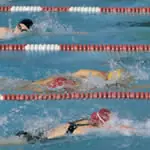In short, I think Terry is great, and naturally, I was disappointed to not be in town for his visit to Cambridge/MIT last spring. He explained how recreational swimmers can try to bridge the gap between their inefficient strokes and wasted effort to swim more like the highly efficient elites: the Phelps and Coughlins of the world.


Thankfully, however, friends of mine at BeginnerTriathlete.com took a video of Terry's talk swimming efficiency talk (http://www.beginnertriathlete.com/cms/article-detail.asp?articleid=1792) at the Multisport World Expo. Several key points from his video:
- Comparing the performance efficiency of Land vs. Water athletes shows the propulsion vs. streamling differnce. Swimmers compare really poorly! Elites are 300% more efficient in their propulsion than recreational swimmers. No wonder Natalie Coughlin and Michael Phelps swim so much faster than me!
- By comparison, Land athletes (e.g. runners) have the propulsion efficiency difference of elites vs. recreational at only 20%. Runners don't get much faster by improving their aerodynamics, right? Running faster simply requires a bigger "fitness engine" -- muscles, lungs, aerobic capacity, etc. Take home lesson: in swimming, hydrodynamics are everything!
- Cooperate with the water, don't fight it. Practice easy and relaxed swimming. Legs should draft behind the body, not kick wide. The fuselage is your body and it must be steamlined. Fewer bubbles with clean entries and less fighting through the water is better. This is accomplished by rotating your body weight and pulling your body over the water rather than dragging it through the water.
- Synchronizing the hip twist and small opposite-foot kick is critical to good rotation and power. You can see a really good video demo of this by Terry on YouTube. Water is a dense medium -- 1,000x more dense than air -- so you can NOT just muscle through it. Swimmers must streamline their bodies from tip to toe. This will lead to efficient strokes, fewer strokes per lap, and easier swimming.

His talk is worth hearing (esp. part 2 which I linked to above, saving you the personal stories of high-school swimming that Terry shares in part 1. If you want to read more about stroke efficiency, tips for "Kaisen" (continuous improvement), and how swimming differs from running then click on those terms for additional articles by Terry at the BT.com website. All are excellent, recommended reading for swimmers!






No comments:
Post a Comment